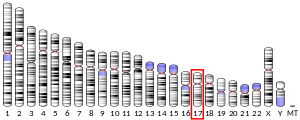From Wikipedia, the free encyclopedia
Protein-coding gene in humans
Cdc42 effector protein 4 is a protein that in humans is encoded by the CDC42EP4 gene .[ 5] [ 6] [ 7]
The product of this gene is a member of the CDC42 -binding protein family. Members of this family interact with Rho family GTPases and regulate the organization of the actin cytoskeleton . This protein has been shown to bind both CDC42 and TC10 GTPases in a GTP -dependent manner. When overexpressed in fibroblasts , this protein was able to induce pseudopodia formation, which suggested a role in inducing actin filament assembly and cell shape control.[ 7]
^ a b c GRCh38: Ensembl release 89: ENSG00000179604 – Ensembl , May 2017^ a b c GRCm38: Ensembl release 89: ENSMUSG00000041598 – Ensembl , May 2017^ "Human PubMed Reference:" . National Center for Biotechnology Information, U.S. National Library of Medicine .^ "Mouse PubMed Reference:" . National Center for Biotechnology Information, U.S. National Library of Medicine .^ Hirsch DS, Pirone DM, Burbelo PD (Mar 2001). "A new family of Cdc42 effector proteins, CEPs, function in fibroblast and epithelial cell shape changes" . J Biol Chem . 276 (2): 875– 83. doi :10.1074/jbc.M007039200 PMID 11035016 . ^ Joberty G, Perlungher RR, Macara IG (Feb 2000). "The Borgs, a new family of Cdc42 and TC10 GTPase-interacting proteins" . Mol Cell Biol . 19 (10): 6585– 97. doi :10.1128/MCB.19.10.6585 . PMC 84628 PMID 10490598 . ^ a b "Entrez Gene: CDC42EP4 CDC42 effector protein (Rho GTPase binding) 4" .
Osada N, Kusuda J, Suzuki Y, et al. (2001). "Sequence analysis, gene expression, and chromosomal assignment of mouse Borg4 gene and its human orthologue" . J. Hum. Genet . 45 (6): 374– 7. doi :10.1007/s100380070012 PMID 11185749 . Strausberg RL, Feingold EA, Grouse LH, et al. (2003). "Generation and initial analysis of more than 15,000 full-length human and mouse cDNA sequences" . Proc. Natl. Acad. Sci. U.S.A . 99 (26): 16899– 903. Bibcode :2002PNAS...9916899M . doi :10.1073/pnas.242603899 PMC 139241 PMID 12477932 . Ota T, Suzuki Y, Nishikawa T, et al. (2004). "Complete sequencing and characterization of 21,243 full-length human cDNAs" . Nat. Genet . 36 (1): 40– 5. doi :10.1038/ng1285 PMID 14702039 . Blackshaw S, Harpavat S, Trimarchi J, et al. (2006). "Genomic analysis of mouse retinal development" . PLOS Biol . 2 (9): E247. doi :10.1371/journal.pbio.0020247 PMC 439783 PMID 15226823 . Gerhard DS, Wagner L, Feingold EA, et al. (2004). "The status, quality, and expansion of the NIH full-length cDNA project: the Mammalian Gene Collection (MGC)" . Genome Res . 14 (10B): 2121– 7. doi :10.1101/gr.2596504 . PMC 528928 PMID 15489334 . Barrios-Rodiles M, Brown KR, Ozdamar B, et al. (2005). "High-throughput mapping of a dynamic signaling network in mammalian cells". Science . 307 (5715): 1621– 5. Bibcode :2005Sci...307.1621B . doi :10.1126/science.1105776 . PMID 15761153 . S2CID 39457788 . Rual JF, Venkatesan K, Hao T, et al. (2005). "Towards a proteome-scale map of the human protein-protein interaction network". Nature . 437 (7062): 1173– 8. Bibcode :2005Natur.437.1173R . doi :10.1038/nature04209 . PMID 16189514 . S2CID 4427026 . Olsen JV, Blagoev B, Gnad F, et al. (2006). "Global, in vivo, and site-specific phosphorylation dynamics in signaling networks" . Cell . 127 (3): 635– 48. doi :10.1016/j.cell.2006.09.026 PMID 17081983 . S2CID 7827573 .







